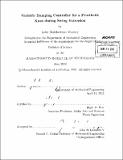| dc.contributor.advisor | Hugh M. Herr. | en_US |
| dc.contributor.author | Mooney, Luke Matthewson | en_US |
| dc.contributor.other | Massachusetts Institute of Technology. Dept. of Mechanical Engineering. | en_US |
| dc.date.accessioned | 2012-12-13T18:50:48Z | |
| dc.date.available | 2012-12-13T18:50:48Z | |
| dc.date.copyright | 2012 | en_US |
| dc.date.issued | 2012 | en_US |
| dc.identifier.uri | http://hdl.handle.net/1721.1/75669 | |
| dc.description | Thesis (S.B.)--Massachusetts Institute of Technology, Dept. of Mechanical Engineering, 2012. | en_US |
| dc.description | Cataloged from PDF version of thesis. | en_US |
| dc.description | Includes bibliographical references (p. 39-40). | en_US |
| dc.description.abstract | Transfemoral amputees exhibit both increased metabolic consumption and gait asymmetry during level ground walking. A variable damping control strategy has been developed for swing extension in order to improve gait symmetry and reduce energy expenditure during level ground walking. Preliminary biomechanical studies suggest that the knee utilizes a variable damping control during swing extension. This thesis proposes a biologically inspired variable damping control strategy which can be simplified into a piecewise function with respect to the knee angle. The variable damping profile of the knee during swing extension has been modeled as an initial linear increase with respect to knee angle followed by a quadratic increase at the end of swing. A damping controller based on this proposed piecewise function has been implemented in a biomimetic, active, knee prosthesis (AAAKP) developed at MIT's Biomechatronics Lab. Preliminary studies on a unilateral, transfemoral amputee have shown that the AAAKP with the proposed damping control strategy is able to more closely emulate the damping profile of the unaffected leg, when compared to a conventional knee prosthesis (Otto Bock C-Leg®). This Initial study suggests that the proposed variable damping strategy for swing extension is able to more accurately emulate the joint mechanics of the unaffected knee. This work is intended to improve prosthetic knee behavior in order to reduce metabolic consumption and improve gait symmetry in transfemoral amputees during level ground walking. | en_US |
| dc.description.statementofresponsibility | by Luke Matthewson Mooney. | en_US |
| dc.format.extent | 43 p. | en_US |
| dc.language.iso | eng | en_US |
| dc.publisher | Massachusetts Institute of Technology | en_US |
| dc.rights | M.I.T. theses are protected by
copyright. They may be viewed from this source for any purpose, but
reproduction or distribution in any format is prohibited without written
permission. See provided URL for inquiries about permission. | en_US |
| dc.rights.uri | http://dspace.mit.edu/handle/1721.1/7582 | en_US |
| dc.subject | Mechanical Engineering. | en_US |
| dc.title | Variable damping controller for a prosthetic knee during swing extension | en_US |
| dc.type | Thesis | en_US |
| dc.description.degree | S.B. | en_US |
| dc.contributor.department | Massachusetts Institute of Technology. Department of Mechanical Engineering | |
| dc.identifier.oclc | 819333819 | en_US |
